Cowrie Shells, Prakab, Pot Duang or Bullet Coins
Before the adoption of banknotes and flat coins, Thailand used Cowrie Shells, Prakab (Baked Clay Coins) and Pot Duang as the money.
Thai Banknotes Evolution
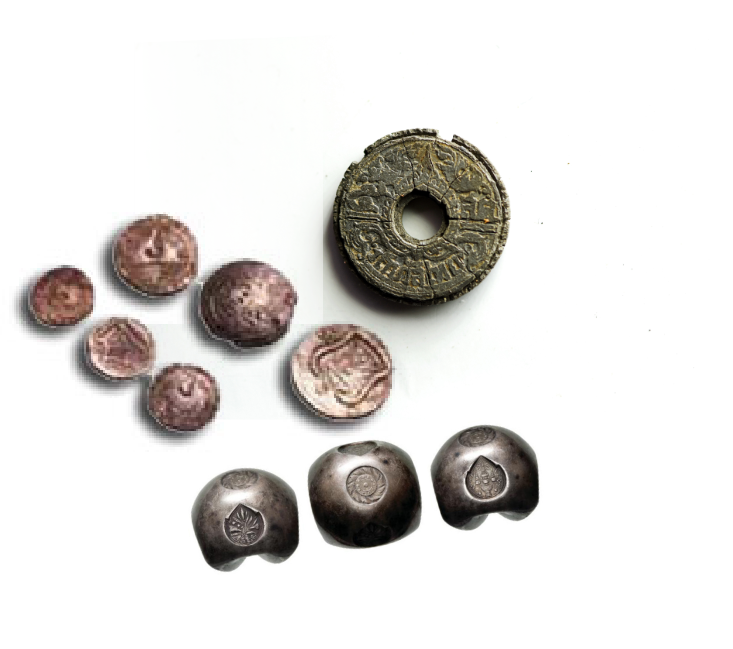
Before the adoption of banknotes and flat coins, Thailand used Cowrie Shells, Prakab (Baked Clay Coins) and Pot Duang as the money.
1853
During the period of His Majesty King Mongkut, Thailand had established diplomatic relations with the great power countries from the west and implemented the free trade. Trade increased enormously as did the need for money. The production of Pot Duang was insufficient to meet the demand as it was a hand-made and counterfeiting also became widespread. In 1853, King Mongkut thus decreed that the first paper money called Mai
Mai were printed on white paper with designs on both sides in black ink. To prevent forgeries, each note was stamped with red Chakra, the emblem of the Chakri Dynasty, and a red Thai-style crown, the insignia of King Rama IV. Mai were originally divided into three types: low - value, medium - value and high - value. Despite the effort to promote the use of this paper money, people still preferred Pot Duang and it thus failed to meet the king's intention.
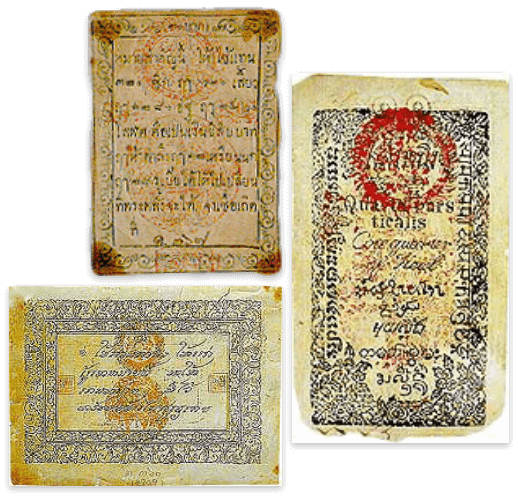
1872 - 1873
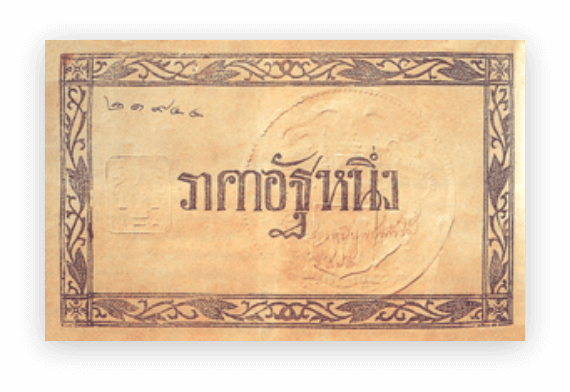
During the period of His Majesty King Chulalongkorn, in 1873, there was insufficient of low-value copper coins since the value of tin and copper on world market rose above the face value of the coins. Therefore, speculators melted copper and tin coins into blocks and exported them abroad.
This shortage caused the public to rely on porcelain Pee or gambling chips used in the gambling house. People could keep and exchange the Pee into money with the gambling house operator later. If the gambling house operator failed to obtain a license, he had to make an announcement to those who held the Pee issued by him to have the Pee changed into money during a specific time. However, people could lose money if they could not exchange on specific time.
To alleviate the shortage of small change that disrupted the small business and to counteract the gambling house's exploitation, the King Chulalongkorn had decreed to issue a low-value paper money called Att Kradat (Low-value Paper Money) to supply the demand of copper coins, which it was not preferred to use, while was waiting for the copper coins ordered from England. The government had issued to use those coins in 1875 and at the same time had completely withdrawn Att Kradat from circulation.
1883, 1898, 1899
Bat Thanakarn or Banknotes. As the government could not supply Thai coins in response to the expansion of economy and trade, Three foreign commercial banks including the Hong Kong and Shanghai Banking Corporation, the Chartered Bank of India, Australia, and China and the Banque de L' Indo-Chine had been granted permission to operate and issue banknotes to expedite the clearing of debts between the bank and its customer in 1889, 1898 and 1899 respectively,
Even though the government had granted the commercial bank to issue their banknotes, the government had reserved its right to deny or accept them. The circulation of banknotes had limited only to a circle of people who were in contact with those three commercial banks. However, it was continually circulated for 13 years (1889 to 1902), making people to be more familiar with paper currency and used to calling them by the English name as banknote or bank which has commonly referred to government-issued banknotes until the present time.
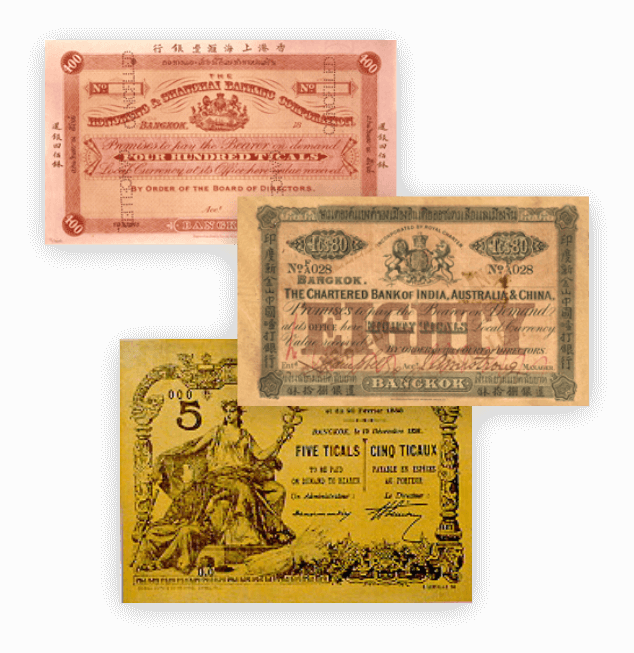
1889
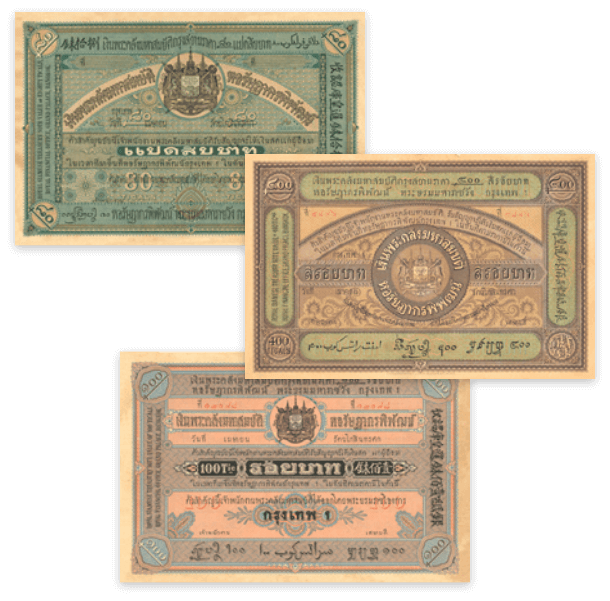
The government had continued to explore several avenues to tackle the shortage of money so as to be able to provide sufficient money supply. The government had considered issuing paper money and announce it to be money of the country replacing banknotes issued by commercial banks. In 1890, the government had prepared to issue a paper money called Ngoen Kradat Luang or Treasury Notes by placing an order with Giesecke & Devrient, Germany. There were 8 denominations in various colors and sizes. Unfortunately these notes were never put into circulation due to inefficiency in banknote management.
1902
The year 1902 marked an important landmark in the inauguration of paper money in Thailand. By Royal Command, the Siamese Currency Notes Act, R.E. 121 was promulgated on June 24, 1902.
There were efforts to introduce paper money to replace silver coins during the King Rama IV's reign, and the success eventually came in the reign of King Rama V by officially inaugurating Thai Banknotes Department under the Ministry of Finance. The department had responsibility in issuing and exchanging banknote which officially served the public for the first time on September 23, 1902. This marked the inauguration of modern Thai banknotes.
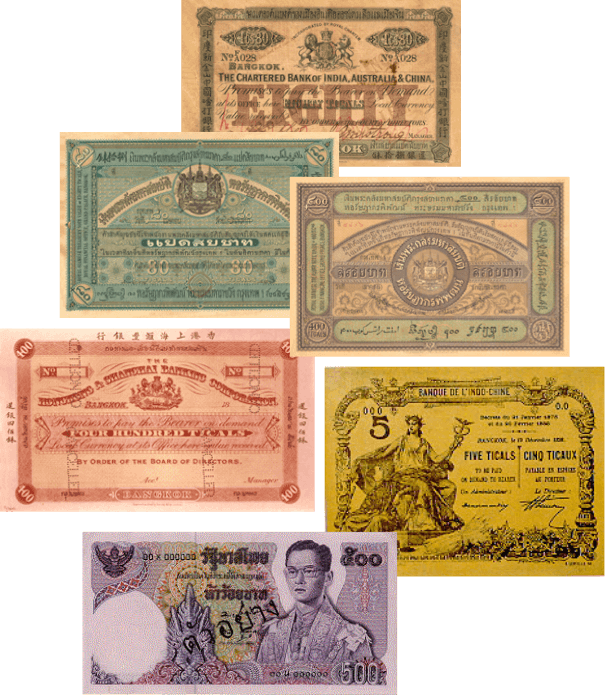
All rights reserved by the Copyright Act B.E. 2537.
Reproduction of banknote images and information in this website for any commercial purpose must be obtained prior permission from BOT.